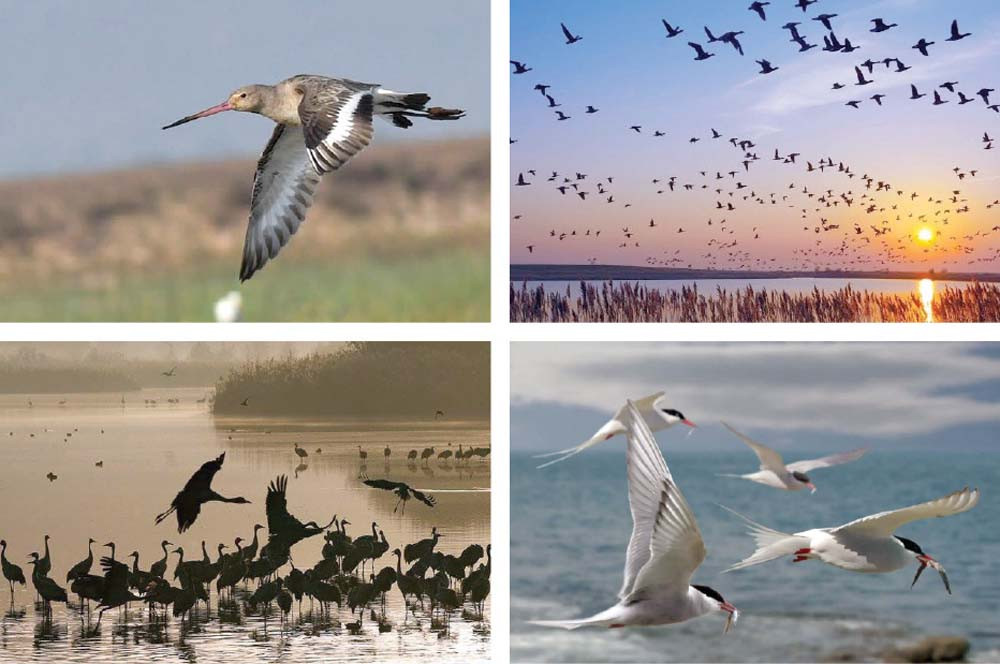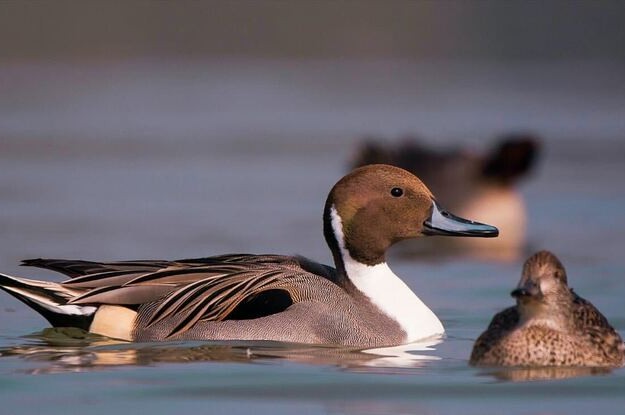
In January 2024, the Sindh Wildlife Department (SWD) has initiated the population census of migratory birds flying in from some of the world’s coldest regions, including Siberia. These birds fly to the water bodies and sea waters in Karachi and rural Sindh. The bird census will continue until mid-March, utilizing a combination of conventional and modern instruments, including spotting scopes, to ensure accurate counting.
Javed Mehr, Conservator of Sindh Wildlife Department, highlighted the successful destruction of hundreds of traps set by poachers at Keenjhar Lake, located at the end of the Indus flyway zone. As winter sets in, these feathered guests from frigid regions, such as Siberia, embark on a journey covering thousands of miles through the Indus flyway zone, ultimately reaching the water bodies of Sindh, including Karachi.
The annual flight of these birds typically commences in November and extends over four months before they return to their original habitats in March. This diverse group of migratory birds includes both water and land species. Experts attribute their migration to milder regions like Pakistan to escape severe cold and snowfall that freeze their food sources in their native lands.
Climate change and other factors, such as the shrinking of water bodies and a lack of fresh water, have influenced the fluctuating numbers of these migratory birds in Sindh. The ongoing bird census spans various districts in rural Sindh, including Karachi. Teams are counting birds in Hawke’s Bay, Hub Dam, Korangi Creeks, Manchar Lake, Keenjhar Lake, and Haleji Lake in Karachi.
At the same time, a comprehensive counting effort is underway in other areas, including Rann of Kutch, Ranpur Dam, Sanga Lake, Bodi Sir Lake, Noori Lake, Phosna Lake, Ach Lake, Crush Lake, Lung Lake, Hamai Lake, Drug Lake, Mehrano Lake, Sufi Anwarshah Lake, Mobho Lake, and Hadero Lake.
To conduct the counts, a square line is established near the water bodies and habitats of these birds, equipped with devices such as spotting scopes. The number of birds within this frame is tallied, and the process is repeated at intervals of a few kilometers to compile an accurate count.
Conservator Javed Mehr emphasizes that previous legal restrictions on bird hunting were exploited by poaching mafias. Stricter measures were implemented in 2020, granting Sindh Wildlife Department teams the status of Wildlife Protection Police. This change has resulted in a positive impact, evident not only in recent years but also in the increasing numbers of birds.
Mehr further notes that due to its extensive area, Keenjhar Lake has been a target for poaching. Legal actions against poachers often face resistance, but a joint effort involving the staff of Sindh Wildlife Department Hyderabad, Thatta, Sjawal, and the Thatta police has seized and destroyed several hundred traps.
The number of migratory birds flying south to the wetlands of Sindh to escape the frigid cold of the Tundra region was recorded at around 661,537, as per the annual bird survey of the Sindh Wildlife Department (SWD). In 2022, the number is more than 49,000 as compared with the last winter.
Though there is no check-in for the feathered guests who are only fair-weather friends, coming with the winter and leaving with spring, SWD uses the traditional method of counting with the help of a telescope.
Conservation teams from villages, towns, and districts send reports, which are then compiled for the estimated number of birds and their species.
At the beginning of the winter season, the influx of migratory birds from all over the world, including Siberia, begins. These migratory birds travel thousands of miles through the Indus Flyway Zone and head for wetlands across Sindh, including Karachi. The process of their arrival starts in the month of November every year.
After a stay of four months, these avian guests return on their homeward journey in March. These migratory birds include both aquatic and terrestrial birds.

In the past, many of them were reported in different wetlands of Sindh including Karachi. However, due to climate change and wetland shrinkage, and some other factors, the numbers remained low.
The Sindh Wildlife Department has released a survey report on migratory birds based on census conducted in January and February 2021. During the recent survey, 16 species of waterfowls, 78 species of wedding birds and more than 80 species of other miscellaneous birds were recorded.
According to Javed Mehar, besides Karachi, survey teams were formed in Sanghar, Nawabshah, Nowshero Feroze, Dadu, Shaheed Benazirabad, Larkana, Qambar Shahdadkot, Thatta and other districts of rural Sindh.
The teams remained continuously active in Hawke’s Bay, Hub Dam, Korangi Creeks and other wetlands like Manchar Lake, Kenjhar Lake and Haleji Lake.
The most tried and tested method is the use of telescope. During this census, a square is drawn in the vicinity of any water body and other devices including spotting scope are installed near it. The number of birds perched in this frame is counted. The same process is repeated over a distance of a few kilometers and this number is compiled gradually.
The number of guest birds was 741,042 in 2019, 248,105 in 2018, 153,916 in 2017 and 1.5 million in 2015. In the 1991 census, the number was recorded at 1,756,890. It should be noted that this series of bird census has been going on since 1972 by the SWD.
The SWD conservator said hunting was allowed under licence in the past. However, a ban was placed to save the depleting population of the migratory birds. Meanwhile, more drastic measures were taken in 2020 to address these factors under which Sindh Wildlife teams were given the status of Wildlife Protection Police and its good results not only appeared in the form of increase in the number of birds this year but also 42 suspects were arrested for illegal bird hunting. In addition to punishments, fines of more than Rs250,000 were imposed. Cases of some suspects are pending in the trial courts.
There has been a rise in the birds visiting the Sindh province, as compared to the previous four years.The survey counted 741,042 migratory birds in the province in 2020 – a huge leap from the 248,105 birds that flew here in 2019. In 2018, the number was 511,112, while in 2017, it was 384,790 and in 2016, it was 375,000.

Yet the Sindh wildlife department (SWD), which has been conducting the survey each year since 1980, was unsure of what had brought about the change.
In the early 1990s, Sindh would have over 1.6 million birds flying here each year. But the number decreased with the passage of time as ‘gun culture’ became a norm in the country.
Meanwhile, SWD chief conservator Javed Ahmed Mahar welcomed the influx as a good omen for the protection and preservation of wildlife in Sindh. “I am not sure of the reason for this, but am happy to share that the number has increased significantly.”

In the case of birds flocking to Haleji Lake, however, he did have an answer – the recent rehabilitation of the wildlife sanctuary. As a result of the lake’s revival, according to him, over 97,000 birds had visited the lake this year, after 4,547 in 2019 and fewer than 9,000 in the previous three years. In 2016, in fact, the number had dipped to a mere 1,630, in stark contrast to this year’s tally.
The survey
Every year, approximately 40 percent of Sindh’s wetlands are surveyed to gain insights into the migratory patterns and numbers of over 80 species of birds.
The 24 sites surveyed across 15 districts encompassed five wildlife sanctuaries and two private reserved. The birds counted included grebes, geese, ducks, pelicans, cormorants, darters, herons, egrets, storks, ibises, spoonbills, flamingoes, cranes, jacanas, passerines and raptors, among many others.
These migratory birds, escaping the cold winter for warmer climes, arrive in Pakistan’s northern regions by the middle of August, flying on to Sindh by November.

“They stay in Sindh till February,” explained Mahar, adding that by May, they would reach their homes once again, remaining there for a couple of months before stretching their wings once again. “They are great travellers, remaining on the move for almost six months each year.”
Pakistan lies on what is known as the ‘Indus Flyway,’ one of the routes travelled by migratory birds. They are creatures of habit too – each species takes the same route for several years without much change, according to Mahar.
In recent years, however, despite a strict check on illegal hunting, countless birds have been targeted by hunters and trappers across Sindh, a SWD official disclosed.
Migratory birds from the world’s coldest region flock to the coastal areas of Pakistan, including the water bodies of Sindh, especially Sea View, Hawke’s Bay and Russian Beach. Every year, these feathered guests fly thousands of miles from Central Siberian tundra to spend three months in the coastal areas of Pakistan. According to birdwatchers, these migratory birds leave Siberia in autumn in search of food and warm weather and enter Pakistan via the Central Asian state of Kazakhstan. They follow an instinctively set flyway during this regular seasonal movement which is one of the great wonders of the natural world.
Flyways are defined as flight pathways taken by migratory birds while moving between their overwintering quarters and breeding grounds. Pakistan is included in the list of countries that are covered by the Central Asian Flyway. The flyway in Pakistan is also known as Green Routes or Indus Flyway Zone. The migratory birds of Pakistan include ducks, cranes, geese, flamingos, swans, flacons, and waders. Their favorite food and wild plants are found in abundance in the freshwater lakes of Sindh and along the coastline.
A flock of migratory birds flying in a particular formation is a mesmerizing sight to behold and you don’t have to be a birdwatcher to appreciate this stunning phenomenon of the natural world.
According to the bird census of 2021- 22, more than 650,000 migratory birds stayed in the coastal areas and water bodies of Sindh, said Mumtaz Soomro, Administrator of the Sindh Wildlife Department.
International Union for Conservation of Nature (IUCN) formed teams at the district level to protect these feathered guests from predators. Usually, they prefer to fly to alternative countries instead of settling on dirt or polluted water.
In December 2022, the Sindh High Court (SHC) rejected a petition seeking lifting of an official ban on hunting of Siberian and local birds in Sindh. The court stated that the petitioner’s counsel had been given two chances but he could not satisfy the court in favor of lifting of the hunting ban. The counsel argued that the influential persons were exempt from the official hunting ban. But the Sindh Wildlife Department said that it issues Categories A, B and C licences for hunting.
The counsel argued that if the Wildlife Department wanted to ban hunting, then it should be applicable to all categories. The petition was filed by Ghulam Ali in which he submitted that while licenses were issued for Categories A, B and C, the actual ban was applicable to Category A only. Furthermore, he submitted that the Sindh cabinet has approved a ban on Category C hunting for the years 2022 and 2023.
